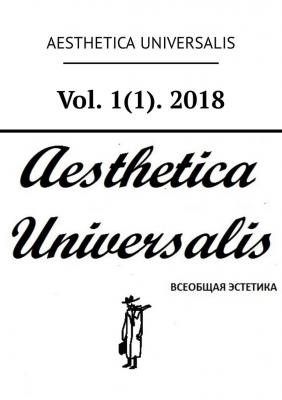ТОП просматриваемых книг сайта:
Vol. 1(1). 2018. Сергей Анатольевич Дзикевич
Читать онлайн.Название Vol. 1(1). 2018
Год выпуска 0
isbn 9785449096876
Автор произведения Сергей Анатольевич Дзикевич
Жанр Философия
Издательство Издательские решения
OUTLOOK
Our imaginary is created essentially through mimetic processes which also use the images of the imaginary to shape the outside world. Images of the human being are key to our understanding of ourselves. They are irreducible. They arise because we communicate about ourselves and must develop similarities and feelings of belonging with other people. They are the result of complex anthropological processes, in which social and cultural power structures play an important role. Owing to their iconic character, they reduce the complexity of the person and his being-in-the-world to select features and do not create a complete view of the person. There are approximations to the homo absconditus, the human being who cannot fully understand himself (Wulf 2013b). In the Ten Commandments there is therefore talk that the human should not create an image of God and by analogy – today we would say – no image should be made from another human being. Images and mimetic processes are important for our relationship with the world, with other people and with ourselves, Image critic is required in order to escape the power of interpretation of images and in particular images of the human being. The same applies to a critical view of the ideas and images created in the discourses on the human being. We must recognise the importance of images, mimesis and imagination for the development of the imaginary and for the understanding of the human being.
LITERATURE
Adorno, Th. W. (1984): Aesthetic Theory. Trans. C. Lenhardt. London: Routledge & Kegan Paul.
Belting, H. (2001): Bild-Anthropologie. Entwürfe für eine Bildwissenschaft. Munich: Wilhelm Fink.
Benjamin, W.: Berlin Childhood around 1900 (2006). Cambridge, MA: Belknap Press of Harvard University Press
Benjamin, W. (1980a): «Über das mimetische Vermögen», in W. Benjamin, Gesammelte Schriften, vol. 2, bk. 1. Frankfurt/Main: Suhrkamp, 210 ff.
Benjamin, W. (1980b): «Lehre vom Ähnlichen», in W. Benjamin, Gesammelte Schriften, vol. 2, bk. 1. Frankfurt am Main: Suhrkamp, 204—210.
Deutsche UNESCO-Kommission (2014): Memorandum zum Post-2015-Prozess.
Gebauer, G., Wulf, Ch. (2018): Mimesis. Arte, Cultura, Società, Bologna:… (American translation. Berkeley: California University Press 1995).
Gebauer, G., Wulf, Ch. (1998): Spiel, Ritual, Geste. Mimetisches Handeln in der sozialen Welt. Reinbek: Rowohlt.
Hüppauf, B., Wulf, Ch. (eds.) (2009): Dynamics and Performativity of Imagination: The Image between the Visible and the Invisible. London, New York, New Delhi: Routledge.
Kontopodis, M., Varvantakis, Ch., and Wulf, Ch. (ed.) (2017): Global Youth in Digital Trajectories. London; New York, and New Delhi. Routledge.
Kraus, A., Budde, J., Hietzge, M., and Wulf, Ch. (ed.) (2017): Handbuch Schweigendes Wissen. Weinheim und Basel: BeltzJunventa, 2017.
Kamper, D. (1986): Zur Soziologie der Imagination. Munich: Hanser.
Paragrana. Internationale Zeitschrift für Historische Anthropologie. Körperwissen. Transfer und Innovation. 25 (2016) 1, ed. by Almut Barbara Renger, and Christoph «Wulf. Berlin: de Gruyter.
Tomasello, M. (1999): The Cultural Origins of Human Cognition. Cambridge, MA: Harvard University Press.
Wulf, Ch. (ed.). (1995): Education in Europe: an intercultural task: Network Educational Science. Münster: Waxmann.
Wulf, Ch. (ed.). (1998): Education for the 21st century: commonalities and diversities. Münster: Waxmann.
Wulf, Ch. (Hg.) (2002): Cosmo, corpo, cultura Enciclopedia antropologica. Milano: Bruno Mondadori (deutsche Fassung: Der Mensch und seine Kultur. Hundert Beiträge zur Geschichte, Gegenwart und Zukunft des menschlichen Lebens. Köln: Anaconda 2010).
Wulf, Ch. (2009): Anthropologie. Geschichte – Kultur – Philosophie. Cologne: Anaconda (2nd Extended Edition, 1st Edition Reinbek 2004: Rowohlt).
Wulf, Ch. (2013a): Antropologia dell’uomo globale. Storia e conctti. Turino; Bollati Boringhieri (American translation; Anthropology. A Continental Perspective. Chicago: The University of Chicago Press).
Wulf, Ch. (2013b): Das Rätsel des Humanen. Eine Einführung in die historische Anthropologie. Munich: Wilhelm Fink.
Wulf, Ch. (2014): Bilder des Menschen. Imaginäre und performative Grundlagen der Kultur. Bielefeld: Transcript.
Wulf, Ch. (2018): Homo imaginationis. Le radici estetiche dell’antropologia storico culturale. Firenze: Mimesis.
Wulf, Ch., Fischer-Lichte, E. (eds.) (2010). Gesten. Inszenierung, Aufführung, Praxis. München: Wilhelm Fink.
Wulf, Ch., Zirfas, Jörg (eds.) (2007): Pädagogik des Performativen. Theorien, Methoden, Perspektiven. Weinheim, Basel: Beltz.
Wulf, Ch., and Zirfas, J. (eds.) (2014): Handbuch Pädagogische Anthropologie. Wiesbaden: Springer Verlag Sozialwissenschaften.
КРИСТОФ ВУЛЬФ2
МИМЕТИЧЕСКОЕ ТВОРЧЕСТВО ВООБРАЖЕНИЯ
Перевод Евгения Доброва3член редакционной коллегии Aesthetica Universalis, [email protected]
Абстракт
Маленькие дети учатся создавать смысл окружающего их мира через миметические процессы. В начале эти процессы сфокусированы на их родителях, братьях, сестрах и прочих знакомых детям людях. Дети хотят быть во всем им подобными. Ими движет желание стать во всем похожими на своих близких, что будет означать, что дети обретут свою принадлежность в круге этих людей, станут частью их мира. Маленькие дети, как и люди в целом являются существами социальными. Люди в большей степени, чем прочие приматы, являются социальными существами, которые не могут выжить без Другого. В миметических процессах внешний мир

